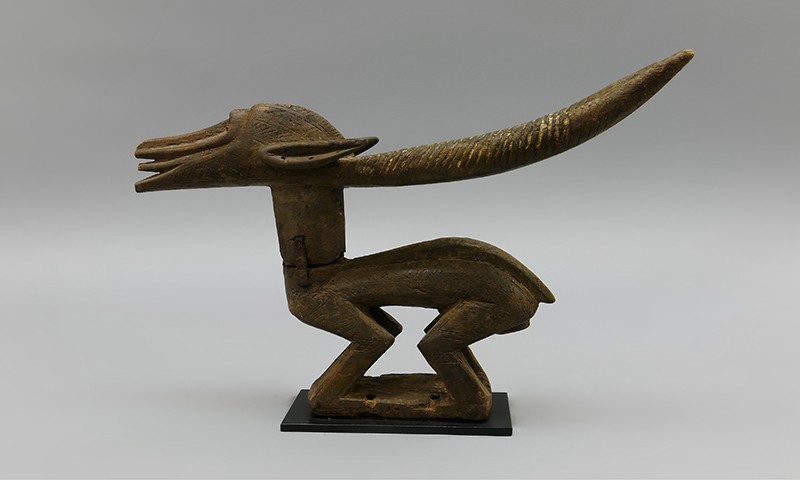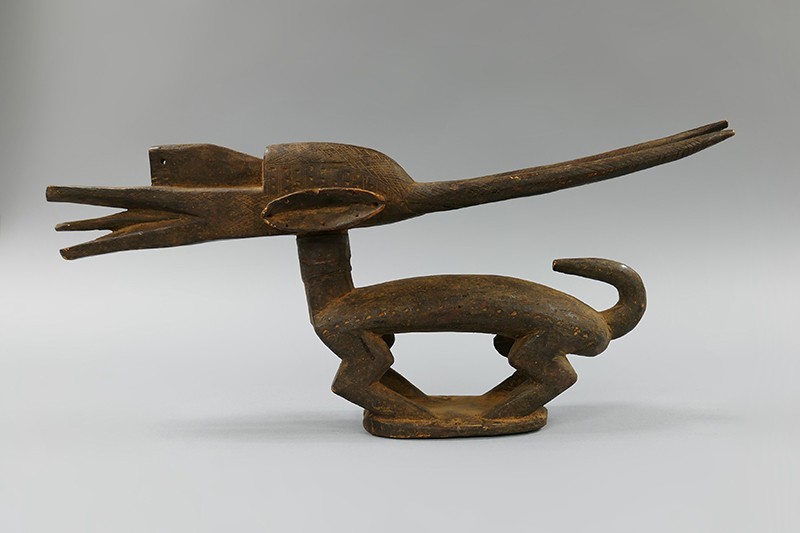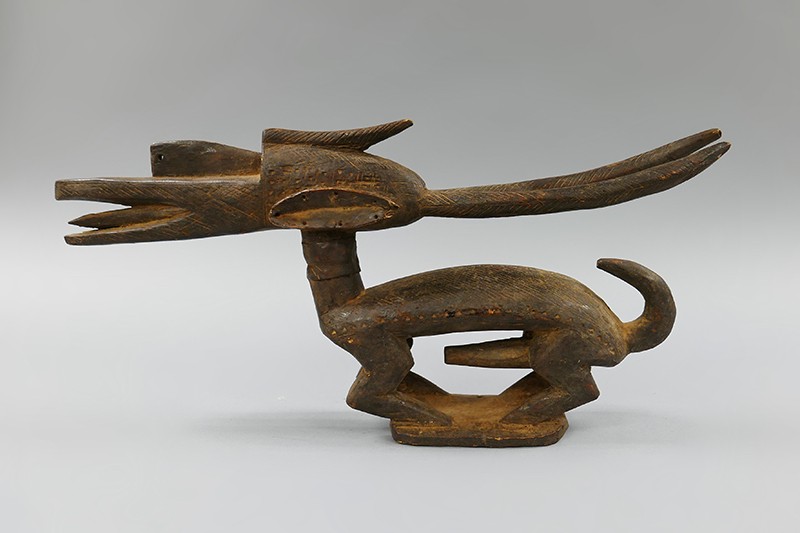Bamana Ciwarakunw: Icons of Agrarian Society
 |
| Headdress (Ciwarakun), 20th Century Bamana culture; Western Mali Wood and metal; 11 × 17 5/8 × 3 in. 2018.13.28 Gift of Anne and Long Shung Shih |
On Demigods and Farmers
Agrarian cultures often have myths about the origin of their farming practices. As the primary source of subsistence for these groups, farming is a lifeline that everything else grows from. In the oral tradition of the Bamana culture of western Mali it was a legendary half-man, half-antelope named Ciwara that was responsible for teaching mankind agriculture. Though the original Ciwara has since disappeared into the earth, the Bamana still honor him with dances following especially rigorous periods of farming. In this post the Bowers Blog uses three newly acquired headdresses that would have adorned the costumes of Bamana dancers to explore both Bamana culture and the specific traditions of the Bamana Ciwara society.
 |
| Headdress (Ciwarakun), 20th Century Bamana; Western Mali Wood; 9 x 21 1/2 x 3 1/2 in. 2019.2.4 Gift of Anne and Long Shung Shih |
Sow and Jow
Bamana is a composite of the culture’s words for ‘refuse’ and ‘man,’ and references the Malian group being one of the few to not convert to Islam after the religion was first introduced to Mali around the 9th Century. While individuals who identify as Bamana are now predominantly Muslim, many acknowledge that in the villages outside of the region’s major cities the ‘true Bamana’ still operate under the same governing traditions that they have for centuries. The individual societies responsible with maintaining and promoting different aspects of Bamana culture, jow in Bamana, do vary somewhat across the vast territory inhabited by the Bamana. The Ciwara society’s role is primarily tied to ciwara dances and promote and reward agricultural efforts. The word ciwara is surprisingly versatile: aside from its reference to the mythological figure and the society venerating him, it is a rough translation of ‘farming animal’, that can be used to refer to especially indefatigable Bamana farmers.
Toiling to Twirl
Ciwara dances tend to occur more organically than other ceremonies, even when compared to other Bamana societies. In one instance an ethnographer reported that after a long day toiling in the fields, a host rewarded farmers with a drink and a meal; elders singled out the farmer who worked hardest on that day and pronounced him a ciwara; and then the entire community was treated to a ciwara performance. Ciwara dances can vary significantly in content, but the one universal standard is that the dances feature at least one pair of young male dancers embodying the male and female characteristics Ciwara. These dancers wear clothing that disguises their appearances, including a cap with hanging raffia that covers their face. They also hold forked sticks that allow them to appear to travel on all fours. On top of this cap is the subject of this post: a wooden antelope headdress or ciwarakun—Bamana is a language of compound words, ‘kun’ is equivalent to head or hat. In this dichotomy the male ciwarakun represents the sun, and the female represents the earth, it is through their union that crops bountifully grow for the Bamana. The dance consists of the two dancers emulating the movements of an antelope as they and their attendants trace a path around the edge of a circular performance space. Other characters such as hyenas and women emulating the ciwara dancers add levity to these events.
 |
| Headdress (Ciwarakun), 20th Century Bamana; Western Mali Wood; 9 1/2 x 21 1/4 x 3 1/2 in. 2019.2.5 Gift of Anne and Long Shung Shih |
The Whole Nine Aard(vark)s
Ciwarakunw generally fit into two to four categories depending on how they are subdivided. Each of these categories speak to the originating geography of the headdress. The Bowers Museum has recently acquired three ciwarakunw, all of which are horizontally oriented, indicating that they originate from the western and southern Bamana. The other variants are all vertically oriented and vary in size, design, and the degree of stylization. Just as the mythological antecedent for ciwarakunw was a hybrid of a man and an antelope, these wooden carvings are also hybrids of animal forms. The pangolin and especially the aardvark, who is known for digging and thus also associated with farmers, are both common to these headdresses. Both the patina and general form of the headdresses are dependent on the carver, but certain features such as holes in the base so that the headdress can be attached to a woven hat and that the head of the figure is made from a second piece of wood—an outlier among African wood carving—are characteristic to all ciwarakunw.
Text and images may be under copyright. Please contact Collection Department for permission to use. References are available on request. Information subject to change upon further research.
Comments